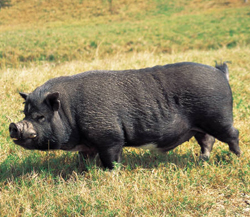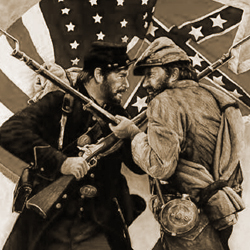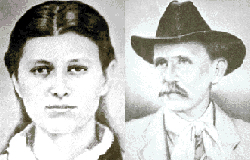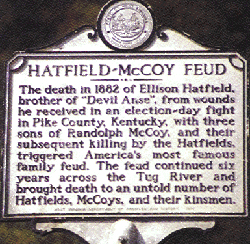
Most people would think that while a pig is a strange excuse for a blood feud, thirteen years between one murder and another in said feud would indicate that they are not connected. Don’t bet on it. My very first paid writing assignment was a local history column for the weekly newspaper in my mother’s hometown. I had never lived there, but I had visited often in the 60s and early 70s and I was fascinated with the county’s history. The column was in celebration of Tennessee’s Homecoming 86, an initiative from then governor, now Senator Lamar Alexander.
At any rate, I was working for the University of Tennessee at Chattanooga in those days, and the local paper did a little feature about my writing. I received a fascinating phone call just a few days after that piece ran. The lady calling was a far distant cousin of sorts, in her 80s, and living in a high rise retirement home in Chattanooga.

But back to the Hatfields & McCoys. The Civil War was at the root of much of the trouble. The McCoys were predominantly Union allies. The Hatfields were more Confederate than not. And those divisions probably colored much of the conflict between the families. In 1878, a dispute arose concerning the ownership of a pig. Floyd Hatfield had possession of the pig, but Randolph McCoy said it was his. With no real way to discern the truth, when the case went to court (presided over by “Preacher Anse” Hatfield to differentiate him from clan leader “Devil Anse”) a mutual relative named Staton provided testimony that sank the McCoy’s claim. Staton was ultimately murdered, but no one was ever convicted of the crime.

This betrayal of their sister Roseanna drove three of her brothers to hunt down and kill Ellison Hatfield, Johnse’s uncle. The same day, the Hatfield clan banded together and hunted down and killed Roseanna’s three brothers. It proved to be the single deadliest day of the feud.
Six years of high tension ensued. Then, on New Year’s Day 1888, the Hatfields surrounded the McCoy cabin and killed two of Randolph McCoy’s children and left his wife beaten and near death. Eventually eight members of the Hatfield clan were tried in Kentucky, with seven drawing life sentences and one the death penalty.
Violence and trials continued through the 19th century. Johnse Hatfield was one of the last tried in 1901.

I find myself returning to another local history interview that I did back in the late 1980s. An old man agreed to meet with me at the family homestead, built by his grandfather in first half of the 19th century. That same grandfather had been murdered by a band of Confederate guerillas while my interviewee’s own father hid under a bed in the next room. As it happened, the leader of the guerilla band was a Hays, just like me. I noticed that the old fellow I was talking to seemed awfully hesitant to answer my questions. Finally, he looked around him and leaned in close. “Are you kin to that Hays scoundrel that killed my grandpappy?”
So that was what was bothering him.
“No, sir,” I responded in all sincerity. “To the best of my knowledge, I am not.”
He visibly relaxed and treated me to a wide and fascinating recounting of his ancestors’ deeds. He even let me see a prized family heirloom—a tooth from his great grandfather, who fought in the American Revolution, recovered when they moved the old veteran’s body to a new burial site.
Family, honor, loyalty. Motives all for revenge.
When Tony Hays isn’t traveling the world, teaching students, and adopting puppies, he takes time out to write the Arthurian Mystery series from Tor/Forge.

This is so sad. Especially the deaths of the children. The motives are interesting. You have to wonder if the first killing hadn’t happened whether the feud would have happened or not. Do you know what the death totals on each side were?
Usually accounts grossly drive the death count up to over a hundred. In reality there was only about a dozen, thought that is a dozen too many. My 3X great grandfather was Randolph McCoy, the leader during the feud. He lost 5 children directly to the feud and 2 indirectly of broken hearts and remorse. He also nearly lost his wife in a brutal attack to which she never did completely recover from. She died about two years later. Kevin Costner and Bill Paxton are filming a 10 hour miniseries movie for the History Channel as I write this and it is scheduled to be released in 2012. Hopef
@Ed – Wow. That was a dozen too many. It must have been so horrible for both families getting in deeper and deeper not being able to trust anything, even if they wanted to stop it. So sad. A real tradgedy. Thank you for sharing this. I will look for the mini-series on History Channel.
I wonder if someone had told ol Ran’l that the argument & hard feelings would cost him the lives of 5 of his children, how it would have changed things.
It’s just a sad story.